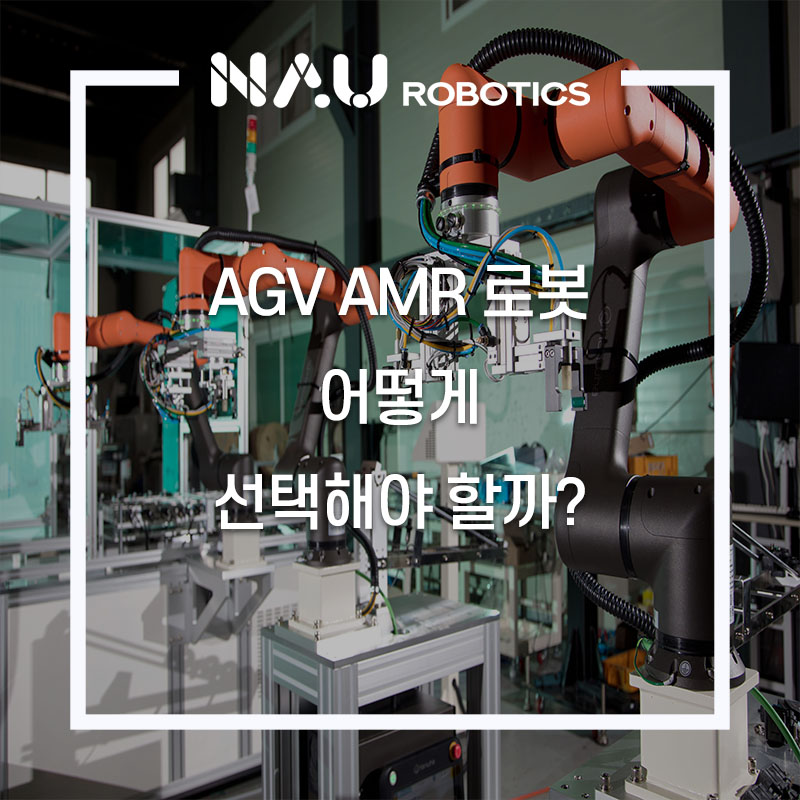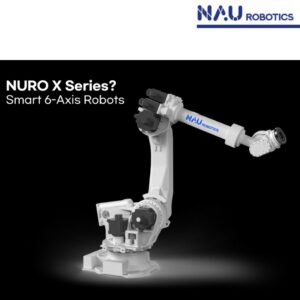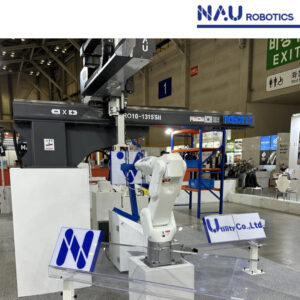안녕하세요! 나우로보틱스 블로그 지기, 나우지기 입니다! 코로나 이후에 무인화, 자동화가 본격적으로 이뤄지면서 자율주행 로봇인 AGV와 AMR 로봇에 대한 수요도 크게 늘어나고 있죠. 특히 창고나 물류시설 등과 같은 곳에서 현재 우리나라의 대기업들도 속속 AGV와 AMR를 도입해서 사용을 하고 있는데요,
하지만 AGV와 AMR이 사실 자율주행, 무인화 등과 같은 영역에서 함께 다뤄지고 있다보니 이것에 대한 차이점을 잘 모르고 혼동하는 경우가 많습니다. 그래서 오늘은 나우로보틱스가 AGV와 AMR 로봇이 각각 어떻게 다른지에 대한 차이점과 그리고 어떤 상황에서는 두 자율주행 로봇 중 어떤 것을 선택하는 것이 좋을지를 한 편의 외신기사를 통해 소개해 드려볼까 합니다. 지금부터 함께 보실까요?

AGV vs AMR: What are the differences and which one do you need in your facility
AGV와 AMR 당신의 공장에 필요한 로봇은 무엇인가?
(E) Today’s manufacturing and logistics industry is facing significant challenges to upgrade and optimize business processes to meet the demands of a modern economy.
(K) 오늘날의 제조, 물류 산업은 경제의 수요를 충족시키기 위해 비즈니스 과정을 향상시키고 최적화해야하는 중대한 도전에 직면해 있다.
(E) Advances in technology make it possible to create more efficient and productive systems through automation and digitization.
(K) 기술의 발전을 자동화와 디지털화를 통해 더욱 효율적이고 생산적인 시스템을 만드는 것을 가능하게 한다.
(E) Global industrial automation is worth approximately $200 billion – and according to the latest market research study by ResearchAndMarkets.com, AGV and AMR Market is expected to reach $13.2 Billion by 2026 with a growth rate of around 35%.
(K) 글로벌 산업 자동화는 약 2000억 달러의 가치가 있는 것으로 알려져 있으며, ResearchAndMakets.com의 최신 시장 조사에 따르면 AGV 및 AMR 시장은 2026년까지 약 35%의 성장률을 보이며 132억 달러 규모로 커질 것으로 전망된다.
(E) That means AGVs, as well as AMRs, are going to become a new normal in day-to-day operational activities in warehouses, factories, and other facilities that could use their potential.
(K) 이는 AMR 뿐만 아니라 AGV가 잠재력을 발휘할 수 있는 창고, 공장, 그리고 기타 시설에서 일상적으로 운영됨에 따라(사용됨에 따라) 새로운 표준이 된다는 것을 의미한다.,
(E) But, what are the differences between AGVs and AMRs, and should you use one of these solutions in your facility? This is something we are going to tackle in the article, so keep on reading.
(K) 그럼 AGV와 AMR의 차이는 무엇이고 어떤 솔루션 중 하나를 시설에서 사용해야 할까? 오늘 기사를 통해 이 부분을 다뤄본다.

What is an Automated Guided Vehicle (AGV)?
AGV는 무엇인가?
(E) AGV robots are wheel-based and computer-controlled load carriers. AGVs follow marked wires or long lines on the floor of a facility without the help of a driver or onboard operator.
(K) AGV 로봇은 바퀴를 기반으로 하며 컴퓨터의 제어를 받는 운반체다. AGV는 운전자 또는 작업자의 도움 없이 시설의 바닥에 표시된 전선이나 긴선을 따라 움직인다.
(E) AGVs use a combination of sensor-based systems and software to navigate. These vehicles move around on a predictable path with controlled acceleration and deceleration.
(K) AGV는 센서 기반 시스템과 소프트웨어를 결합해 탐색한다. 이러한 차량은 가속과 감속이 통제된 예측 가능한 경로로 이동한다.
(E) Hence, they offer a safe way of moving loads around. Industries use AGVs in transporting materials around large industrial buildings.
(K) 이런 방법으로 AGV는 짐(물건)을 안전하게 이동시킬 수 있도록 해준다. 산업현장에서는 대형 건물 안에 자재를 운반할 때 주로 사용한다.
(E) There are various types of AGVs which include:
(K) AGV에는 다음과 같은 종류들이 있다.
Automated carts: This is the simplest type with minimal features and low implementation cost
Automated forklift AGVs: Forklifts with automatic controls allowing for unmanned operations
Unit load AGVs: These are individual vehicles used to transport loads on AGVs’ decks
Tugged AGVs: Powered units that pull non-motorized trailers carrying loads.
(K) 자동카트: 이 유형은 최소한 기능과 낮은 비용이 특징이며 가장 단순하다.
자동지게차AGV: 무인운행이 가능하면서 자동제어 기능이 있는 지게차
단위부하AGV: AGV 갑판에서 짐을 운반할 때 사용되는 차량
견인AGV: 짐을 운반하는 비동력 트레일러를 끄는 동력장치
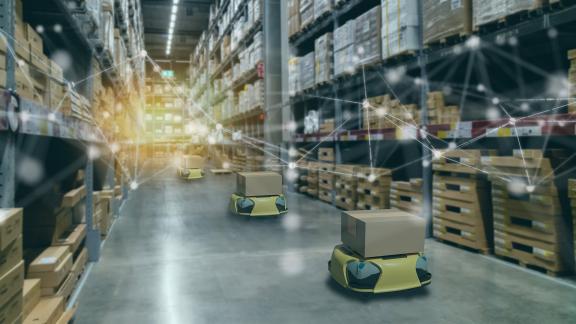
What is an Autonomous Mobile Robot (AMR)?
AMR은 무엇인가?
(E) An autonomous mobile robot is a robot that understands and moves around a facility floor without an operator.
(K) AMR은 사용자가 없어도 시설을 파악하고 스스로 움직이는 로봇이다,
(E) The robot can move around with the help of computers, onboard sensors, and maps. It can understand and interpret its environment, thus offering asynchronous transportation.
(K) AMR 은 컴퓨터, 온보드 센서, 그리고 지도 등을 바탕으로 움직인다. 주변 환경을 이해하고 해석할 수 있으며 비동기식 전송을 제공한다.
(E) AMRs offer increased flexibility by creating their routes within a facility or warehouse. They can identify obstacles and reroute when necessary without the intervention of an operator.
(K) AMR은 시설이나 창고내에 경로를 만들어 유연성을 높인다. 작업자들이 나서지 않아도 장애물을 식별하고 필요할 때 경로를 변경할 수도 있다.
(E) Thus, AMRs are best suited for dynamic environments because of their independence and flexibility.
(K) 그래서 AMR은 독립성과 유연성 특징 덕분에 동적인 환경에 갖아 적합하다,
(E) Industries use AMRs for a variety of operations, which include:
(K) AMR은 다음과 같은 현장에 사용된다.
Transporting materials and finished goods within a warehouse or facility (창고 또는 시설에서 자재나 완제품 이송)
Facilitating the sorting process (정렬 작업 진행)
Facilitating the picking process (픽업 작업 진행)
Increased inventory visibility, i.e., viewing and tracking inventory in real-time (재고 가시성 향상, 실시간 재고 확인 및 추적)

What are the differences between AGVs and AMRs?
AGV와 AMR의 차이는 무엇인가?
(E) Both AGVs and AMRs are used to automate industrial operations mostly to transport heavy materials across facilities – warehouses, distribution centers, factories, etc.
However, they are different in the following ways.
(K) AGV와 AMR은 대부분 창고, 물류센터, 공장 등 시설 전반의 중자재를 운송하고 운영을 자동화하기 위해 사용된다. 그러나 다음과 같은 면에서 차이를 보인다.
(E) 1. Navigation
AGVs are programmed to follow fixed routes. AGVs use wire, sensors, magnetic strips, or laser guidance technology for navigation.
Laser guidance technology is popular because it is easy to use and accurate. Because it uses a fixed route, an AGV will stop when it encounters obstacles.
On the other hand, AMRs use maps that the AMR software constructs onsite or pre-loaded facility drawings to navigate.
These robots can therefore learn their surroundings and choose the most effective route. AMRs can go round obstacles using intelligent navigation.
As much as this ability can be seen as an advanced option – you have to be aware of it when you are transporting materials within your facility.
For example, if you need to carry very heavy materials, the fact that an AMR can go off course without any decision from a human element can be troubling.
(K) 1. 내비게이션
AGV는 고정된 경로를 따라 움직이게끔 프로그래밍 돼 있다. AGV는 와이어, 센서, 마그네틱 스트립 또는 레이저 유도 기술을 항법에 사용한다.
레이저 유도 기술은 사용하기 쉽고 정확해 선호도가 높다. 이 기술은 고정된 경로에 사용되기 때문에, AGV가 장애물에 부딪힐때는 멈춘다.
반면 AMR은 소프트웨어가 현장 또는 시설 도면을 탐색하기 위해 구성한 지도를 사용한다. 따라서 이 로봇은 주변 환경을 학습하고 가장 효과적인 경로를 선택할 수 있다. AMR은 지능형 내비게이션이 장착돼 장애물을 우회할 수 있다.
이러한 기능은 고급 옵션으로 볼 수 있지만 시설 내에서 자재를 운반할 때 이 기능을 잘 알고 있어야 한다. 예를 들어 매우 무거운 자재를 옮겨야할 떄 AMR이 작업자의 결정 없이 경로를 이탈할 수도 있어 문제가 될 소지가 있다.
(E) 2. Flexibility
AGVs follow strict routes, which are integrated into the facility. An AGV will perform the same task throughout its life. Rerouting an AGV will require making changes to the facility’s floor.
AMRs are flexible and need a simple software adjustment to perform a different task. An AMR will automatically make the necessary adjustment to meet the changing production needs and environment.
As mentioned earlier, using this kind of technology may not be suitable for any kind of facility.
(K) 2. 유연성
AGV는 시설에 표시돼 있는 경로를 정확하게 따른다. AGV는 경로를 변경하려면 바닥을 바꿔야 한다.
AMR은 유연하면서 다른 작업을 수행하기 위해 간단한 소프트웨어 조정만 하면 된다. AMR은 변화하는 생산요구와 환경을 충족시키기 위해 필요한 조정을 자동으로 한다.
앞서 언급했듯 이러한 종류의 기술을 사용하는 것은 어떤 종류의 시설에도 적합하지 않을 수 있다.
(E) 3. Installation and Commissioning
AGVs require complex infrastructures such as magnetic tapes and wires, which are installed into the facility. The process will therefore take time and may lead to disruption of the production process.
AMRs do not need any physical infrastructure to be set up during installation. AMRs can be deployed easily and quickly; hence don’t disrupt the production process during their installation.
(K) 3, 설치와 커미션
AGV는 도입시 시설에 설치되는 자기 테이프와 와이어 등과 같은 복잡한 기반 장비들이 필요하다. 따라서 이공정은 시간이 걸리고 생산 공정에 차질이 생길 수 있다.
AMR은 도입시 추가적으로 물리적인 장비를 설정할 필요가 없다. AMR은 쉽고 빠르게 도입과 확산이 가능해 설치 중에도 생산과정이 중단될 필요가 없다.
(E) 4. Price
AGVs are simpler thus more affordable than AMRs. The navigation system in an AGV is less complex and does not have a lot of sensors.
AMRs use more complex and sophisticated software, which makes them more expensive. AMRs require more performance sensors and a more advanced control panel to manage all the information received from the sensors.
(K) 4, 가격
AGV는 AMR보다 더 간단하여 저렴하다. AGV의 내비게이션 시스템은 덜 복잡하고 센서가 많이 필요하지 않다. AMR은 좀 더 복잡하고 정교한 소프트웨어를 사용하기 때문에 센서로부터 모든 정보를 관리하기 위해 더 많은 성능 센서와 향상된 제어가 필요하다.
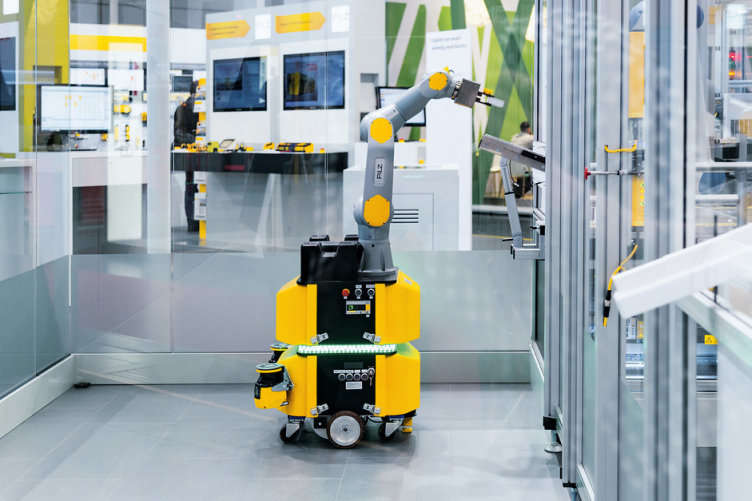
Choosing the best for your facility
당신의 시설에 맞는 가장 좋은 선택은?
(E) AMRs and AGVs have different applications and are suitable for various facilities based on the facility’s needs.
(K) AMR과 AGV는 응용하는 분야가 서로 달라 시설 요구에 따라 다양한 설비에 적합하다.
(E) AGVs are more suitable for less complex operations. If you need a robot to move materials, work-in-progress or finished goods around the facility or warehouse, then AGVs are ideal for your facility.
(K) AGV는 단순한 작업에 적합하다. 시설이나 창고 주변에서 작업 중인 제품 또는 완제품을 이동하기 위해 로봇이 필요하다면 AGV가 이상적인 선택이다.
(E) For example, your facility may need an AGV to transport raw materials to the production line from the warehouse. Additionally, the AGV will transport the finished goods to the warehouse for distribution.
(K) 예를 들어 창고에서 생산라인으로 원자재를 운송할 때는 AGV가 필요할 수 있다. 또한 AGV는 유통을 위해 완제품을 창고로 운송하는 역할을 한다.
(E) On the other hand, AMRs are suitable for a more dynamic work environment. If your facility doesn’t have fixed routes for moving materials or needs a robot that you can use for other operations, then AMRs are ideal.
(K) 반면 AMR은 역동적인 작업에 적합하다. 만약 고정된 경로가 없거나 다른 작업에도 사용할 수 있는 로봇이 필요하다면 AMR이 이상적이다.
(E) For example, you can use an AMR for transporting, loading, retrieving, and staking materials in a warehouse. Its flexibility makes it ideal for such dynamic activities.
(K) 예를들어 AMR을 사용해 창고에서 재료를 운반, 적재, 검색 및 보관을 할 수 있다. 따라서 유연하면서 역동적인 작업에 적용하기에 좋다.
(E) AGVs are ideal for facilities with a greater amount of fixed operations, such as warehouses and factories. They can be programmed to follow a specific route and automatically return when they reach the end.
(K) AGV는 창고나 공장처럼 고정된 상태로 운영하는 시설에 이상적이다. 특정 경로를 따라 끝부분에 도착하면 다시 되돌아오도록 프로그래밍이 가능하다.
(E) AMRs are suitable for facilities that have more dynamic operations, such as hospitals or airports. It is therefore essential to assess your needs, understand the technology and identify what is the best for your facility.
(K) AMR은 병원이나 공항처럼 보다 다양하고 역동적인 시설에 적합하다. 기업의 요구를 평가하고 시설에 가장 적합한 것이 무엇인지 파악하는 것이 중요하다.

